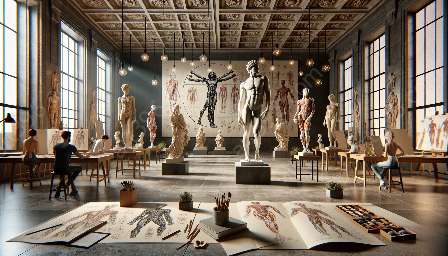Understanding skeletal anatomy is crucial for artists seeking to accurately depict the human form. The study of artistic anatomy emphasizes the skeletal system as the foundation for representing the body in various forms of art, including drawing, painting, and sculpture. An in-depth exploration of the landmarks and key features of skeletal anatomy in art will enhance an artist's ability to create lifelike and expressive representations of the human form.
Skeleton in Artistic Anatomy
Artistic anatomy involves the study of the human body and its representation in visual arts. The skeleton plays a central role in this discipline, serving as the structural framework upon which muscles, tissues, and skin are arranged. By comprehensively understanding the landmarks and key features of skeletal anatomy, artists can accurately capture the proportions, movement, and expression of the human body. This knowledge allows artists to bring a sense of realism and dynamism to their artistic representations, whether in traditional or contemporary art forms.
Key Landmarks and Features
Several key landmarks and features must be considered when depicting skeletal anatomy in art. These include:
- Skull: The skull is one of the most iconic and recognizable features of the human skeleton. It comprises the cranium and the facial bones, and its structure significantly influences facial expressions and head positioning in art.
- Spine: The spine, or vertebral column, provides the central support for the human body. Understanding the curvature and articulation of the spine is essential for creating accurate portrayals of posture and movement.
- Ribs: The ribcage encases and protects vital organs, and its shape and position greatly influence the contours of the torso in artistic representations.
- Pelvis: The pelvis serves as the foundation for the lower body and is critical for understanding the proportions and balance of the human figure. Its structure and orientation impact the portrayal of the hips and lower torso in art.
- Limbs: The skeletal structure of the arms, legs, hands, and feet plays a crucial role in defining the proportions, gestures, and dynamic poses of the human figure. Understanding the joint articulation and bone structure of the limbs is essential for creating convincing and expressive depictions.
Significance in Art
The landmarks and key features of skeletal anatomy hold significant importance in the world of art. Through an in-depth understanding of skeletal anatomy, artists gain the ability to accurately represent human forms with depth, accuracy, and emotive power. This knowledge allows artists to capture the nuances of movement, expression, and anatomical realism in their artistic creations. Whether in the realm of classical figurative art or avant-garde expressions, the integration of skeletal anatomy in artistic representations serves as a cornerstone for evoking a deeper connection between the artwork and its viewers.
By mastering the depiction of skeletal anatomy in art, artists can infuse their creations with a sense of vitality, empathy, and narrative resonance. The landmarks and key features of skeletal anatomy become the guiding principles that enable artists to breathe life into their artistic visions, transcending mere physical representation to evoke emotional and intellectual engagement.

